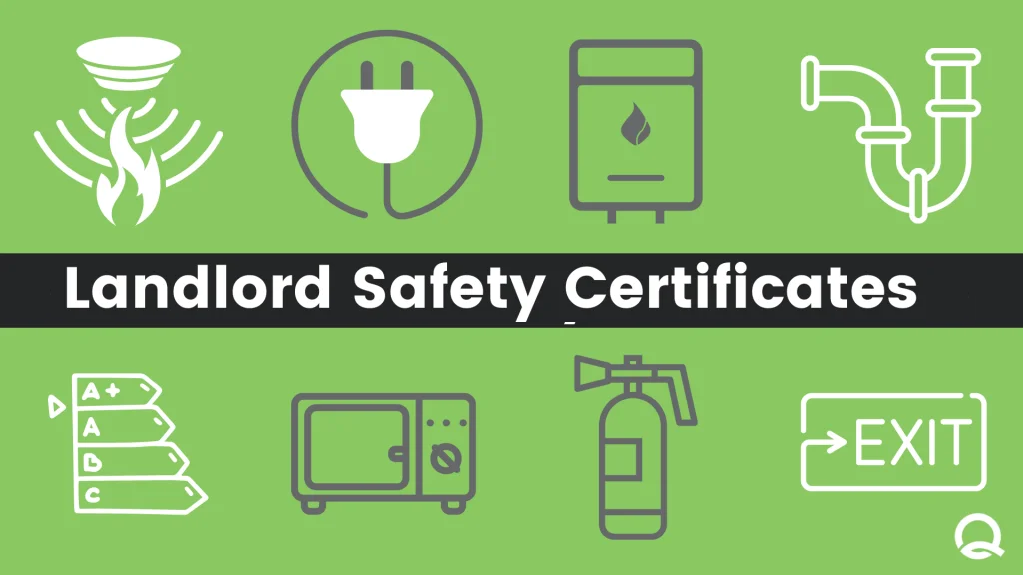
This section is information specifically for leaseholders’ including responsibilities, project plans, budget and financial information, the lease, mandatory and testing reports, insurance, reports on building and fire safety, etc.
Pre-renting
Before you can let your property in the UK, you must have safety inspections on your property. These inspections will confirm that your rental property is safe and meets all the legal requirements.
There are 6 essential safety reports you must have:
- Gas safety certificate
- Electrical safety certificate
- Energy performance certificate (EPC)
- Proof of deposit protection
- Legionella risk assessment
- Fire safety assessment
Gas Safety Certificate
By law, you must have a registered Gas Safe engineer to check all gas appliances (i.e., boiler and gas oven), fittings, chimneys, duct and paperwork annually. After the inspection, the engineer will provide you with a CP12 certificate that lists all the checks carried out. The certificate provides evidence that the gas appliances in the rental property have been checked for safety.
You must provide a copy of the certificate to your tenants before they move in within 28 days of the inspection, and also give them a copy of the updated certificate each year.
Electrical Safety Certificate
Landlords in the UK must have an Electrical Safety Certificate for their rental properties. You will receive this certificate after a qualified electrician prepares an Electrical Installation Condition Report (EICR) by inspecting your property’s electrical installations. Qualified electricians must have the necessary certifications to give the certificate.
The EICR will confirm that the property’s electrical installations (i.e., fuse box, light fittings, plug sockets and wiring, and permanent fixtures like air conditioning units and extractor fans) are safe and meet current standards. If there’re any issues, the electrician will provide recommendations and a timeframe for any necessary repairs. The certificate must be renewed every 5 years or sooner if recommended by the electrician.
You must give a copy of the electrical safety report to existing tenants within 28 days and to new tenants at the start of their tenancy. You must also supply the local authority with a copy of this report within 7 days of receiving a request for a copy.
Proof of Deposit Protection
You must protect your tenant’s deposit in a government-approved tenancy deposit scheme (TDP) within 30 days of receiving the payment until the end of the tenancy. You must also provide your tenants with information about the scheme used, their contact information and how to retrieve their deposit at the end of the tenancy.
There are 3 government-approved tenancy deposit scheme options available in the UK:
- Deposit protection service
- My deposits
- Tenancy deposit scheme
You can face penalties (i.e., monetary fines) and legal action if you fail to provide proof of deposit protection.
Legionella risk Assessment
Landlords are also responsible for ensuring that their rental properties are free from legionella bacteria, which can cause Legionnaires’ disease. These bacteria can exist in all manufactured hot and cold water appliances, such as air conditioning, heating systems, and water pipes.
As a landlord, you must have a qualified professional to carry out a Legionella Risk Assessment to identify potential risks under the Control of Substances Hazardous to Health Regulations 2002 (COSHH) framework. You’re also responsible for taking steps to eliminate the risks.
The risks from hot and cold water systems in most residential settings are generally considered low. By implementing simple measurements, you can ensure the risks stay this way:
- Setting temperature control parameters for water storage cylinders (calorifiers) (for hot water 60°C or higher, for cold water below 20°C)
- Flushing out the water systems before letting the property
- Keeping water moving
- Prevent junk from getting into the water systems by installing tight lids
- Removing redundant pipes
- Installing instantaneous water heaters (i.e., combi boilers and electric showers) You must also inform your tenants about their duties to keep the property legionella bacteria-free, such as regularly cleaning showerheads and informing you about any problems with the water system.
A test certificate isn’t required legally. But you should provide the assessment to your tenant before moving in and keep a copy for your records. Otherwise, your tenant can sue you under the Health and Safety at Work Act if exposed to the bacteria.
Note: BCML commission regular Legionella and water safety testing; the results of which are available on our website
Fire Safety Assessment
While there isn’t any specific legal fire safety certificate, landlords are responsible for ensuring their rental properties meet fire safety regulations.
Fire safety measurements you must take according to regulations are:
- Installing at least 1 working smoke alarm on each floor of the property.
- Installing carbon monoxide alarms in rooms with solid fuel-burning appliances (i.e., wood-burning stoves).
- Checking all alarms are working before a new tenancy starts.
- Providing upholstery and furniture according to the regulations of the Furniture and Furnishings (Fire) (Safety) Regulations 1988
- Provide fire extinguishers in HMOs.
In conclusion, safety certificates play a vital role in ensuring the safety of people and properties in the UK.
As a landlord, it’s your responsibility to ensure that your property has all the necessary safety certificates before letting it out to tenants. Failure to comply with the regulations can result in fines, legal action, and, most importantly, endangering lives.
Disclaimer
The text of this page does not constitute professional legal or other advice and its should not be relied on in order to fulfil any legal obligation which the reader may be required to comply.